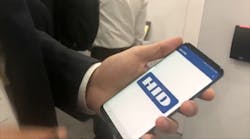Tech Trends: The Next Wave of Sensor Technology
This article originally appeared in the April 2022 issue of Security Business magazine. When sharing, don’t forget to mention Security Business magazine on LinkedIn and @SecBusinessMag on Twitter.
There is a new technology that can be found in building occupancy sensors, certain laptop manufacturers, location and asset management systems, and even Apple Air Tags: Ultra-Wideband (UWB). These technologies are being incorporated into IoT sensors and consumer electronics because of the accuracy and detail the technology can provide.
UWB has been around since the mid-1990s, but only recently has the technology matured for use in the commercial market. UWB technology now rivals Bluetooth as a communications technology and has the potential to replace it in the next few years. Apple has already installed both UWB and Bluetooth transceivers in new Apple Air Tags to increase range and accuracy.
Where Bluetooth operates in the 2.4GHz range with an accuracy of approximately 1 meter and a data rate of less than 3Mbits, UWB operates between the 3.1GHz and 10.6Ghz with an accuracy of less than 10cm. UWB frequencies enable data rates of 7 to 27Mbits, potentially allowing even video surveillance data to be transmitted along with other data for up to 200 meters, twice that of traditional category cable.
UWB Applications in Security
There are two different types of UWB technologies – UWB Radar and UWB Real Time Location Systems (RTLS). The use cases for both are still being developed but are already extensive.
The security industry has only recently scratched the surface of UWB and its potential use-cases, including next-generation motion detection, people counting and occupancy sensing.
Since UWB radar is being used for vital sign monitoring, the next step may be medical alert sensing, where AI-enabled sensors can identify a medical emergency without human interaction and initiate alarm.
UWB RTLS solutions will continue to be used for “Find My Device” applications, but could grow into not only tracking, but also protection applications such as infant protection or wandering patient tags, where location and medical is needed.
In Depth: UWB Radar
Ultra-wideband radar has been around since the mid-1990s for Department of Defense (DoD) and medical applications. It consists of a single point sending a radar signal out, then listening for the return, similar to sonar. Where sonar needs a large surface, UWB radar has a range of 200 meters and is accurate to less than 10cm.
UWB radar has been deemed medically safe, and with the right hardware and software, can provide accurate contactless vital sign monitoring, including heart rate, respiratory rate, and temperature – all devoid of Personally Identifiable Information (PII) concerns.
Most recently the security industry has seen UWB radar used in presence detection and vital sign monitoring for building occupancy and smart buildings for both lighting controls and healthy building applications.
According to Michael Johnson, Enterprise Solutions Manager for Orion Entrance Control: “With regard to the use of UWB as a presence sensing technology, we see buildings that are self-aware, that can report to first responders where the heartbeats are, buildings that can direct people away from danger through integrated systems, all because the building knows where the heartbeats are, and more importantly, where they aren’t.”
Real-world use-cases of this technology could include:
- Presence Detection for green building / LEED certification using UWB sensors instead of passive infrared (PIR) motion sensors.
- Building occupancy for determining the number of individuals in a space without concern of PII.
- At-home health monitors, to include baby monitors as well as home health aides. The use of a desktop monitor to measure human vitals, sleep apnea, and more.
- FDA cleared for approved contactless vital sign monitoring in healthcare.
- High-resolution contact tracing
- Fall detection
- Collision avoidance technologies for use in smart cities, smart agriculture
- AR/VR positional awareness and communication
In Depth: UWB RTLS
Unlike UWB radar, UWB Real-Time Location System (RTLS) – also known as “fine ranging” UWB – consists an anchor and a tag. Tags send out a “blink message” – a short burst of location data any corresponding anchor can then detect.
UWB RTLS technologies use Time of Flight (ToF) to measure the distance between two transceivers. There are four types of RTLS applications:
Two Way Ranging (TWR): TWR is typical in the consumer electronic industry. The anchor, usually a phone, is paired with a tag in a point-to-point connection. A number of manufacturers are installing both UWB and Bluetooth in tags for “Find My Device” applications.
Time Difference of Arrival (TDoA): TDoA is the most complex. Its accuracy is based on device density – triangulation in X, Y, and Z coordinates. Anchors must be time synchronized so that when a tag “blinks” the anchor will timestamp it and share the data between anchors to determine location. The denser the anchor coverage is, the more accurate the tag location.
Reverse TDoA (RTDoA): Reverse TDoA is similar in detail to GPS in a specific location, and with location accuracy to within inches to GPS accuracy of feet. Reverse TDoA is based on the tag “blink” and an anchor response.
Phase Difference of Arrival (PDoA): PDoA combines the TWR and TDoA applications to create three-dimensional positioning using a single anchor. The anchor in this application must have two antennas and be able to measure the differences in time that each phase responds in.
According to ABI Research, UWB RTLS is expected to reach 500 million annual shipments in 2022, growing to 1.5 billion by 2026. Real-world use-cases of this technology could include:
- Wayfinding applications
- Desk/seat usage
- Smart AV applications based on anchor to tag messaging
- “Find My Device” applications
- Passive Keyless Entry for secure access to vehicles or buildings
- Secure Payment Solutions based on IEEE 802.15.4a/z
- RTLS for Tracking – loss prevention and tracking applications across every industry
- RTLS for people flow
- RTLS for Livestock health and movement monitoring
The Future of the Technology
The future use of UWB in the security industry is only going to increase. This technology trend has the potential for being the next generation of IoT sensors that will propagate the alarm industry, healthcare sensors and smart buildings. For now, it is the cool new kid on the block.
Editor’s Note: At CES 2020, HID Global featured hands-on demos showcasing how UWB can provide complete freedom of movement to transform how users engage with smarter, more connected buildings with their smartphone. Check out a quick video at www.securityinfowatch.com/21120731.
Jon Polly is the Chief Solutions Officer for ProTecht Solutions Partners www.protechtsolutionspartners.com, a security consulting company focused on smart city surveillance. Connect with him on linkedin: www.linkedin.com/in/jonpolly.






